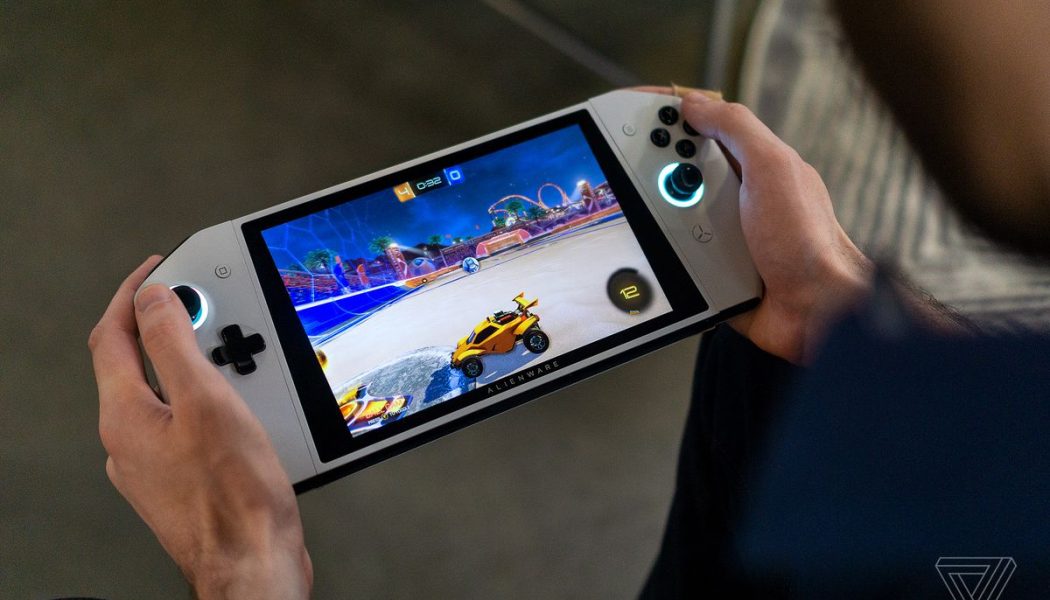Looking through the deluge of CES articles is like staring into an unreliable crystal ball: maybe what you’re looking at is the future, the shape of tech for years to come, or maybe it’s something that’ll get talked about for a week and never heard from again.
That’s why we here at The Verge like to take some time to look back at the biggest hits from CES shows of yesteryear. What looked like it was just a one-off at the largest tech tradeshow in the world, but actually turned out to be a real product? What got a lot of buzz and then dropped off our radars, only to resurface months later? And, of course, what was simply too good to be true?
In that spirit, let’s look at the most popular devices from CES 2020, as well as some products from even further back that are still kicking around in our minds, and ask “hey, whatever happened to the…?”
:no_upscale()/cdn.vox-cdn.com/uploads/chorus_asset/file/19571934/bfarsace_191203_3855_0001.jpg)
Current status: No indication it’ll move out of the concept stage
Alienware’s Concept UFO was a dream machine: a Nintendo Switch-style handheld device powered by the type of components you’d find in a budget gaming PC. It could run Rocket League and Mortal Kombat 11 in our brief demo time with the device last year — and it was in fact a real, working prototype with detachable controllers and a handheld Switch-style mode for playing on the go. Alienware pitched the Concept UFO as the type of radical gadget that could make PC gaming more accessible by cramming a full Windows 10 platform into something you could carry out of the house.
Unfortunately, the Concept UFO remains just that — a concept. We’ve not seen or heard anything of the device since last January, and that was to be expected. Alienware would not confirm at the time it had any intention of making a real, consumer version of its Windows handheld. That’s sad, because among the many frivolous and often indulgent prototypes and concepts at a trade show like CES, the Concept UFO was precisely the type of product we’d actually want to see on the market. There’s always next year.
Current status: Someone probably actually owns one now!
LG comes to CES every year to show off a slate of both real products and not-so-real products, with the latter category populated by its experimental brand of shape-shifting displays. The main event for LG this past few years has been a rollable OLED screen that can expand from a small base station into a massive panel — the kind of futuristic tech we used to only dream about. The catch: despite LG’s constant claims otherwise, this thing kept missing its release windows.
And then something miraculous happened: it finally came out — in South Korea only. Sure, at $87,000, it costs in the same ballpark as the most premium Tesla you can buy. But it did go on sale, and presumably someone out there actually bought it. LG has since moved on from using its rollable TV as the experimental centerpiece of its CES showing, choosing instead its new rollable smartphone. The company says that device is coming in 2021, but we’ll believe it when we see it.

Current status: Vaporware
Segway’s S-Pod brought back that old-school, “what in the hell” CES vibe we here at The Verge have often yearned for in recent years. The S-Pod is an egg-shaped motorized wheelchair of sorts powered by the same gyroscopic self-balancing technology you see in Segway’s traditional and iconic two-wheeled scooters.
But in what feels like some deranged head nod to the Hoverchair from Pixar’s WALL-E, this thing can travel 24 miles per hour, fast enough to make it an alarming hazard for the rider and anything that gets in their way in pretty much any public setting. If that’s not the kind of Las Vegas-style opulence CES is known for, we don’t know what is.
Sadly, the S-Pod is not really anywhere to be found a year later. At the time, Segway told The Verge it planned a 2020 launch for businesses and a 2021 launch for consumers, though it didn’t yet have a price to announce. Now, the S-Pod is listed on Segway’s website as a concept, something it definitely wasn’t pitched as back at CES 2020.
:no_upscale()/cdn.vox-cdn.com/uploads/chorus_asset/file/19580944/razer_tomahawk_2200.jpg)
Current status: Dicey
When the Razer Tomahawk was announced at CES 2020, it was reminiscent of a dream from CES 2014: the one of the modular desktop computer. Of course, most desktop gaming PCs are modular, but Razor’s vision for the concept was simple and clean: there’s a box, and in that box there’s another box that does the computing, alongside a graphics card. No bending pins trying to put in a CPU, no getting a motherboard that’s DOA, just an Intel compute unit and a graphics card slotted into a (frankly astonishingly) small case.
At the moment, it’s hard to call this dream realized. The Tomahawk was supposed to launch in July, but July came and went with no computer. In October, Razer launched a computer case, devoid of any compute units, which it also called the Tomahawk, perhaps a throwback to the never-shipped Tomahawk Elite case it showed off at CES 2019. Then, in December, it finally happened: the Tomahawk desktop computer with the Intel NUC and a RTX 3080 finally went up for pre-order.
Er… maybe. As far as we can tell, it’s been listed as out of stock since then, and so far I haven’t been able to find anyone online claiming to have gotten theirs. I contacted Razer to ask if it had actually started shipping the computers yet, but at time of writing I hadn’t heard back. Needless to say, I’m not quite ready to call this one done, until packages start hitting doors, and until stock becomes available again. As for the Intel NUC that formed the heart of this computer…
Current status: On sale, but when are upgrades coming?
Intel’s NUC concept has been around for a while (I even used a 2017 NUC 7 as my main computer for a year or two), but CES 2020 was the first time that Intel really tried to sell the concept to hardcore gamers. The pitch was that the NUC 9 Extreme could be a tiny, fully upgradable modular gaming computer, with users really only needing to worry about a computing card and a graphics card. But the concept would only work if Intel kept the compute cards updated, and actually released upgrades that consumers could buy…
You knew where this is going, right? This year, Intel announced its 11th generation CPUs, and yet the most recent compute units you can buy for the NUC 9 are still using Intel’s 9th Gen chips. That’s forgivable for existing owners, since the NUC 9 only went on sale last April, but it’s a little worrying we haven’t heard about any upgrade boards yet after a promise they’d be coming each year for two years. While the form factor is still exciting, it seems hard to justify dropping that much cash on the ecosystem until Intel shows more dedication. Cautionary tale: the Alienware Area-51m’s similar CES dream of an unusually upgradable gaming rig was dashed after just one year.
:no_upscale()/cdn.vox-cdn.com/uploads/chorus_asset/file/19580309/sony_vision_s_0400.jpg)
Current status: We have proof of life
I think it’s fair to say that a fully functional electric car wasn’t on most people’s radar when they were theorizing about what Sony would show off at CES 2020. But that’s exactly what Sony showed off with its Vision-S Concept, and it made one fact very clear: you cannot buy one of these. So while we weren’t expecting it to be out on the streets in February, we did wonder if Sony had built an entire car just to show off.
The answer appears to be no. It’s still not on sale, or even rumored to be on sale, but it seems that Sony’s been testing it on public roads since July. The car also got some airtime in Sony’s CES presentation this year, but that didn’t seem to come with much new information other than that testing of the car had begun in Austria. It’s hard to tell what the future holds for this car, but we at least have confirmation that Sony’s still working on it, and is willing to share at least some details on its progress.
:no_upscale()/cdn.vox-cdn.com/uploads/chorus_asset/file/19575887/Fisker_Ocean_Unveil_CES_and_Los_Angeles.jpg)
Current status: Delayed
Speaking of electric cars, Fisker showing one off was more than we expected from Sony, but the company’s Ocean SUV still managed to make a splash. Part of that interest could’ve been due to the solar-panel roof, or the aggressive $37,500 starting price tag, or, maybe people were just interested in seeing if Fisker would actually be able to get a car to the mass market this time.
Either way, at the announcement Fisker stated that the SUV was slated to launch at the end of 2021 or at the beginning of 2022, but that’s now been pushed back to “late 2022”. The car does still seem to be in development from the latest news, with reports coming out that Fisker has found a manufacturing contractor to actually build the car. Whenever it releases, Fisker is really going to have to deliver, seeing as the competing Tesla Model Y and Mustang Mach-E will have been on the road for a while at that point.
:no_upscale()/cdn.vox-cdn.com/uploads/chorus_asset/file/19575515/SamsungSero.jpg)
Current status: It exists
When Samsung announced at CES 2020 that the Sero, its TV that used motors to switch from landscape to portrait, was going to be available outside of Korea, the response seemed to be a resounding “uh… why?”
But the mocking of the masses didn’t stop it from hitting store shelves. This summer, the Sero blew all the doubters away, showing that the form factor was not just appropriate, but in fact elevated the medium of internet video in ways… no, I’m just kidding, the reviews were pretty middling. Still, it’s nice to see something that seemed like it could just as easily have been a CES pipe dream go on sale to consumers. You could actually buy one right now if you really wanted, because, while it’s apparently not a great viewing experience, it is one of the few TVs that’s built to do what it does.
:no_upscale()/cdn.vox-cdn.com/uploads/chorus_asset/file/19576607/IMG_6160_2.jpg)
Current status: Real and real expensive
Keeping on the topic of TVs, the show-stopping ones at CES are always ahead of their time, with resolutions and screen technologies debuting years before mere mortals start to get their hands on them. Samsung continued that trend at CES 2020 with its all-screen 8K TV, the Q950. At the time, the company didn’t announce a price, but the TV has since gone on sale… for a cool $10,999.99.
Samsung, and others, have since released 8K TVs around the $2,000 price range, but a year later, there’s still not a ton of value in buying an 8K TV. There’s only a handful of cameras that can shoot in 8K, and almost no one is mastering and releasing in the resolution. Outside of the very uppermost echelons of PC gaming, you’d be hard-pressed to find a device that can even output in full resolution to an 8K TV: while the new Xbox Series X and PS5 do physically support it, their operating systems don’t yet (though that didn’t stop Sony from putting it on the box).
Speaking of the PS5…
:no_upscale()/cdn.vox-cdn.com/uploads/chorus_asset/file/22015304/vpavic_4278_20201030_0247.jpg)
Current status: A powerful purchase… if you can find one
CES is rarely a place for console gaming — that’s more the purview of E3. But PlayStation maker Sony does show up every year, usually to announce new televisions, home audio, and other gadgets. Last year, we got all hyped up for a big PlayStation 5 announce which turned out to be… the logo. That’s all we got, with the reveal seeming even more overblown by the fact the PS5 logo is pretty much identical to the PS4 one.
Of course, most of us know that the rest of the year’s PS5-related announcements were much more exciting. Sony, like many other gaming companies, skipped E3 amid the coronavirus pandemic (though the company made that decision before COVID-19 arrived in the US). In April, we saw the DualSense controller for the first time, followed by an official hardware review in June. And in September, we got a launch-day slate and price reveal at long last, ahead of the official November launch.
Now, a year later, the PS5 is actually in consumers’ homes, if you’ve been lucky enough to get your hands on one.
:no_upscale()/cdn.vox-cdn.com/uploads/chorus_asset/file/19576271/dbohn_ces2020__5.jpg)
Current status: Not worth your time
Withings got some interest with its ScanWatch, which promised to detect atrial fibrillation and measure blood oxygen levels during the wearer’s sleep. It also doesn’t look like a smartwatch, so it promised to provide all the health tracking that people wanted but in a form factor they were more comfortable with. Unfortunately, reviewers found it lacking in a couple of key areas, but for many people that doesn’t even matter — the watch still hasn’t been cleared by the FDA, so it can’t be sold in the US, though it is available elsewhere in the world.
:no_upscale()/cdn.vox-cdn.com/uploads/chorus_asset/file/19870216/gblackmon_200403_3960_quibi_0005.0.jpg)
Current status: It went full Go90
It’s rare you get a slow-motion car crash in the tech or media industries as visible and painful to watch as Quibi. But there it was: a brand-new streaming service with nearly $2 billion in funding, a seriously impressive slate of talent aboard, and two well-known industry figures from the world of Silicon Valley (HP’s Meg Whitman) and Hollywood (big-shot film producer Jeffrey Katzenberg) working together to realize their vision of a mobile-centric video app that could transcend the sorry fates of the Verizon Go90’s of the past.
Quibi came to CES 2020 last year to sort of, not really soft-launch the service, despite being unwilling to even show the app before its official April debut. And the rest is Quistory, as us Quibi aficionados like to say (just kidding, we made that up). The app came out in April, when the coronavirus pandemic was in full swing and much of the US was sheltering in place and learning to adapt to the new normal of life during COVID-19. That could have bolstered Quibi’s chances for success, but the company was ill-equipped to handle the new reality. It failed to launch critical features, like AirPlay and Chromecast support, fast enough, and it didn’t even deliver native streaming set-top box apps until October, a full six months after launch.
On top of all that, Quibi’s content… well, it sucked. There were no viral hits and few outside media circles seemed to care that Quibi had launched at all. This disastrous recipe culminated in an eventual shutdown announced in October, which everyone except Katzenberg seemed to see coming months prior. Roku has since scooped up the app’s content library after Quibi turned the lights off in early December. The company’s legacy now doubles as a cautionary tale, proving that money and connections and an old-school Hollywood mentality can’t create a new hit video app out of thin air. Especially not when your competition on mobile is the organic, user-generated gold just a few taps away on TikTok and Twitch.
:no_upscale()/cdn.vox-cdn.com/uploads/chorus_asset/file/19589602/intel_dg1_xe_lp_gpu_graphics_card_003.jpg)
Current status: Still waiting on desktop cards, but laptop versions are starting to appear
Intel showing off its discrete GPU at CES last year was really one thing masquerading as another: the eye-catching part was an honest-to-goodness graphics card that you could slot into your desktop, made by Intel. But what Intel was really showing off was its dedicated graphics technology, the Xe architecture. So far, we haven’t seen that desktop card, though there are rumors that it’s coming sometime next year.
Intel’s dedicated Xe graphics, however, have started showing up in various laptops. Of course, we’ve seen Xe graphics tech in Tiger Lake’s integrated GPUs and been impressed, but there are also laptops with Intel’s Iris Xe Max — a separate, totally dedicated graphics chip. And how is it? Well… for gaming, it often gets beat by integrated graphics, which may explain why we haven’t seen a desktop version yet. It does have other use cases, such as video encoding, but it seems like the dream of Intel being a third competitor to AMD and Nvidia in terms of gaming graphics is some way off at this point.
:no_upscale()/cdn.vox-cdn.com/uploads/chorus_asset/file/22232289/MK62_Hero_Transparent.png)
Current status: Immediately outclassed
When it was announced at CES 2020, the system was one of the cheaper ways to get a Wi-Fi 6 mesh network. It managed to launch on time, but the reviews were pretty mediocre, and now it’s got plenty of Wi-Fi 6 competition. But if you really like the design, it is actually available for purchase on store shelves.
This product’s fate really goes to show what a difference a year can make — we were excited about Wi-Fi 6 mesh systems at last year’s CES, but that’s old hat now. It’s all about Wi-Fi 6E now, baby. And, of course, mesh systems using that newer tech have been announced at this year’s CES.
:no_upscale()/cdn.vox-cdn.com/uploads/chorus_asset/file/19562029/C_by_GE_No_Neutral_Wire_Dimmer_Motion_Switch_Front.jpg)
Current status: Available but iffy
What set GE’s Smart Switch announcement apart from the crowd was compatibility — they came in a standard four-wire version that could be wired into modern lighting systems, but they also came in a three-wire version that could be installed in almost any home without a neutral wire. This was a feature decidedly uncommon in the smart home space, which is what makes the reviews for these switches such a shame.
To be clear, they did actually come out. I always see them at my local Lowes. But looking at the Amazon or Best Buy reviews, it’s clear a lot of buyers are not having a great experience with their software. And while that’s something that could be fixed, it’s never recommended that you buy something based on the promise that it could be good later, doubly true if you’ll be wiring that thing into your walls.
Robo-Friends
:no_upscale()/cdn.vox-cdn.com/uploads/chorus_asset/file/22230757/Screen_Shot_2021_01_12_at_11.07.49_AM.png)
Samsung’s Ballie
Samsung’s Ballie robot was supposed to be, as the name implied, a spherical robot that helped you out around the house. Samsung made no promises about shipping or price, and we’ve heard pretty much nothing since. I reached out to Samsung to ask if the Ballie was being worked on and it responded with a statement:
We continue to develop the core technologies of our concept robots, including Ballie to deliver new and unique experiences and functionality. In fact, this year we have applied one of Ballie’s core technologies to JetBot90+ AI as we continue to push the boundaries of home assistant technologies.
I do have to say, though, that the JetBot 90 AI Plus is far less cute than the Ballie. Ah well.
:no_upscale()/cdn.vox-cdn.com/uploads/chorus_asset/file/22230678/Screen_Shot_2021_01_12_at_10.27.39_AM.png)
Charmin’s RollBot
Okay, we’re aware that Charmin’s robot built to bring you toilet rolls was mostly a joke, but how perfect that this was what kicked off our 2020. It obviously hasn’t come out as a product that you can buy, but maybe this year Charmin can announce a battle bot that’ll fight other bots at the grocery store to snag you the last package of TP.
:no_upscale()/cdn.vox-cdn.com/uploads/chorus_asset/file/19550608/MarsCat___10_min.jpg)
The MarsCat
The MarsCat from Elephant Robotics stole a lot of hearts and even ended up on Stephen Colbert’s Late Show. It launched as a Kickstarter right before CES 2020, with the company saying early backers would get their robotic companions in March of 2020. Today, it’s on Indiegogo, and it doesn’t seem like anyone has received theirs yet. The ship date is now March 2021, and the company’s been releasing updates and YouTube videos, but it seems like we’re seeing the common crowdfunding story play out here again.
:no_upscale()/cdn.vox-cdn.com/uploads/chorus_asset/file/19585576/DSC00641.jpg)
Current status: Pivoted to enterprise so you’ll never ask about it again
Nothing screams vaporware quite like the phrase “artificial human.” Yet Samsung’s Neon, despite the lack of concrete details on the purported artificial intelligence project, generated an alarming amount of buzzy press while remaining shrouded in mystery. So it goes at CES, where any kind of breakthrough tech is hyped up to infinity.
What Neon actually ended up being was a digital avatar project with some impressive facial animation technology, but nothing anywhere close to the artificial human benchmark the company repeatedly set for itself.
Where is Neon now? Not on Galaxy smartphones as a chatbot, or on any smartphone, app, website, or game for that matter. No, instead Neon has apparently shifted to an enterprise solution in the form of an API businesses can use to enhance real-time conversation needs like customer service, according to Android Authority. Meanwhile, Neon project lead Pranav Mistry has since walked back his comments about a consumer version of Neon coming to Samsung devices. After Bixby, could we really expect anything less?
:no_upscale()/cdn.vox-cdn.com/uploads/chorus_asset/file/19584336/DSCF4877_2.jpg)
Samsung Odyssey G9
Current status: Awesome but out of stock
The Samsung Odyssey G9 demanded attention through its specs and sheer physical size — it’s a 49-inch, 240Hz, curved gaming monitor with phenomenal resolution and brightness. Show attendees were dazzled.
It launched at an eye-watering $1,500, and when we reviewed it we did have to wonder whether “the ultimate ultrawide” was what we were really looking for. What we didn’t question, however, is that this monitor was absolutely deserving of that title. Actually getting your hands on the monitor, though, has been less thrilling. Early buyers reported a variety of issues, which slowly got fixed, but now you suddenly can’t buy it anymore.
It seems like it’s no longer easily available outside of eBay — Samsung tells us the reason stores are showing them as unavailable is due to “an unprecedented demand,” and says it’s definitely not discontinued, but I can’t put a product you’re not actually able to buy in the Winner’s Circle, now can I?
:no_upscale()/cdn.vox-cdn.com/uploads/chorus_asset/file/19855768/awhite_200319_3954_6.jpg)
Current status: Available and truly excellent
The Zephyrus G14 was one of the first laptops announced with Ryzen 4000, which were the first chips to bring AMD’s Zen 2 architecture to laptops. While we knew that Zen 2 was good on desktops, it wasn’t proven in mobile — and the G14 didn’t have a price, so whether it would be a good deal or not was also an open question.
That question has been answered: the G14 launched starting at $1,049, but the real sweet spot was the $1,449 model with an RTX 2060 Max-Q. The Verge loved its design and gaming prowess, and I’ve personally recommended it to a friend or two (and I’ve heard good things from the ones who bought it.) And look, it just got a sequel at this year’s CES.
:no_upscale()/cdn.vox-cdn.com/uploads/chorus_asset/file/19576504/loradicarlo1.jpg)
Sex toys, and the Lora DiCarlo company in particular, have a rocky history with CES. At CES 2019, the company’s Osé Robotic Massager won an Innovation Award in robotics and drones — and then CES took the award away and barred Lora DiCarlo from exhibiting, citing some pretty shaky reasoning. The company, however, was allowed back in 2020, and was able to show off its products. As a bonus, the toys it showed actually exist, and are available for purchase (if you can afford their relatively high price tags, that is.)
What we didn’t know when all this drama happened at the beginning of the year, however, was what a great year the sex toy industry was about to have due to the pandemic putting restrictions on any kind of socializing. In a year where a song as explicit as “WAP” was number one on the charts for weeks, it seems this CES controversy may have been one of the most portentous things to come out of the show in 2020. Here’s to a better (and less lonely) 2021.










